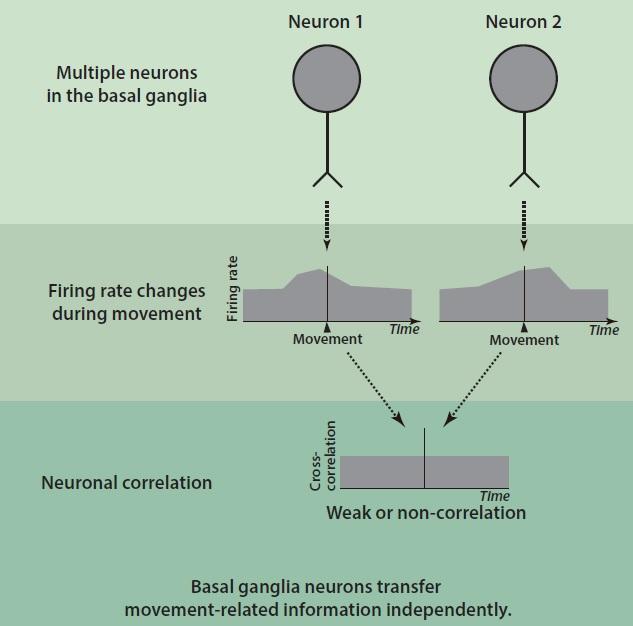November 16, 2020
The firing rate changes or the correlated neuronal activity; which is the chief to control the motor signal in the basal ganglia of healthy monkeys?
SOKENDAI Publication Grant for Research Papers program year: 2020
WONGMASSANG WORANAN, Physiological Sciences
Weakly correlated activity of pallidal neurons in behaving monkeys
Journal: European Journal of Neuroscience publish year: 2020
DOI: 10.1111/ejn.14903
Bibliographic information of awarded paper

Schematic drawing of the summary of the present study. Activity of multiple basal ganglia neurons located in the arm regions was recorded while monkeys performed a hand-reaching task. Simultaneously recorded two neurons (top) exhibit firing rate increases around the time starting a hand movement (middle). However, these neurons exhibit non-correlated activity (bottom). In the present study, most neuronal pairs exhibited weak or non-correlated activity, although they showed firing rate changes during the hand-reaching task. These results suggest that basal ganglia neurons transfer movement-related information independently.
Neurons transfer the information to another group of neurons, either by increasing or decreasing their activity ("firing rate change") or showing the synchronized activity ("correlated neuronal activity"). The basal ganglia are a brain region important for motor control. However, so far, how the basal ganglia transfer the information during movement had not been investigated.
In this study, we recorded the activity of one of nuclei in the basal ganglia (called "globus pallidus") while monkeys perform a hand-reaching task. The present study revealed that most neurons showed firing rate changes during arm movements (figure, top and middle), whereas only a small proportion of neurons showed correlated activity and most pairs exhibited weak or non-correlated activity (figure, bottom). These results suggest that basal ganglia neurons code the information by firing rate changes. In addition, our findings might be useful for developing the treatment for Parkinson's disease. In Parkinson's disease model monkeys, neurons in the globus pallidus show the significant synchronized activity. We believe that the correlated activity might be one of the keynotes of abnormality in such monkeys.
Bibliographic information of awarded paper
- Title: Weakly correlated activity of pallidal neurons in behaving monkeys
- Author name: Woranan Wongmassang, Taku Hasegawa, Satomi Chiken, Atsushi Nambu
- Journal title: European Journal of Neuroscience
- Publication year: 3 July 2020
- DOI: https://doi.org/10.1111/ejn.14903
School of Life Sciences, Department of Physiological Sciences
WONGMASSANG WORANAN
